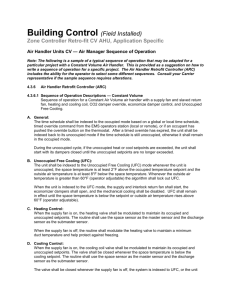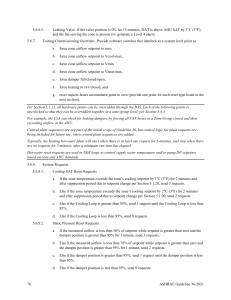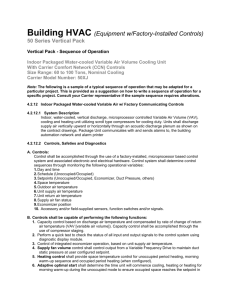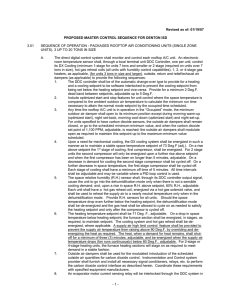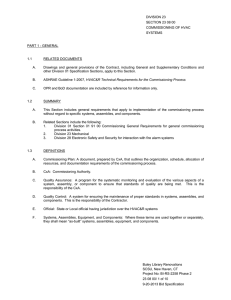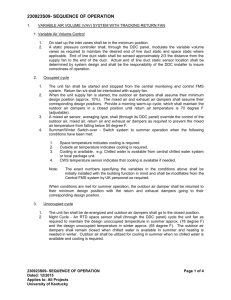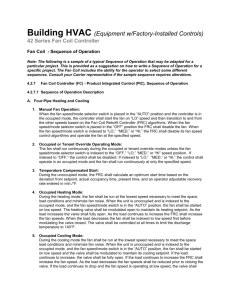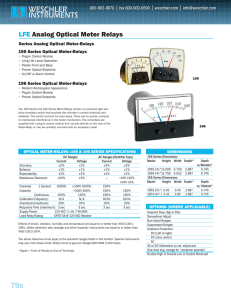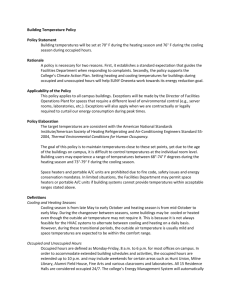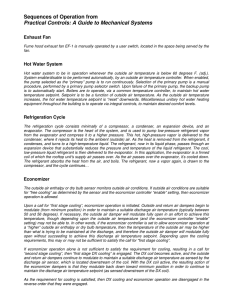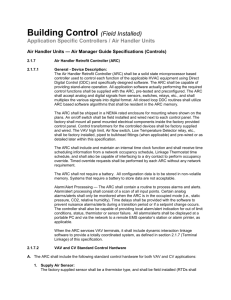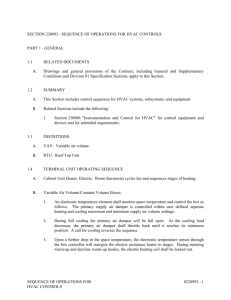4.3.7 Zone Controller, Retrofit VAV Air Handling Units, Air Manager
advertisement
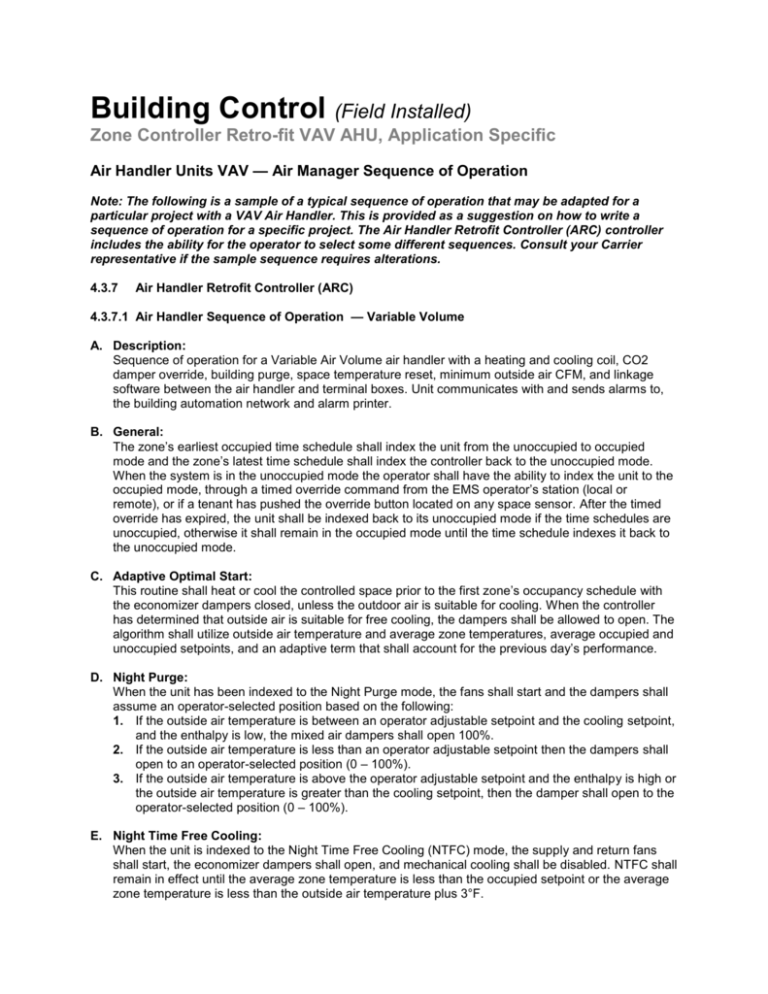
Building Control (Field Installed) Zone Controller Retro-fit VAV AHU, Application Specific Air Handler Units VAV — Air Manager Sequence of Operation Note: The following is a sample of a typical sequence of operation that may be adapted for a particular project with a VAV Air Handler. This is provided as a suggestion on how to write a sequence of operation for a specific project. The Air Handler Retrofit Controller (ARC) controller includes the ability for the operator to select some different sequences. Consult your Carrier representative if the sample sequence requires alterations. 4.3.7 Air Handler Retrofit Controller (ARC) 4.3.7.1 Air Handler Sequence of Operation — Variable Volume A. Description: Sequence of operation for a Variable Air Volume air handler with a heating and cooling coil, CO2 damper override, building purge, space temperature reset, minimum outside air CFM, and linkage software between the air handler and terminal boxes. Unit communicates with and sends alarms to, the building automation network and alarm printer. B. General: The zone’s earliest occupied time schedule shall index the unit from the unoccupied to occupied mode and the zone’s latest time schedule shall index the controller back to the unoccupied mode. When the system is in the unoccupied mode the operator shall have the ability to index the unit to the occupied mode, through a timed override command from the EMS operator’s station (local or remote), or if a tenant has pushed the override button located on any space sensor. After the timed override has expired, the unit shall be indexed back to its unoccupied mode if the time schedules are unoccupied, otherwise it shall remain in the occupied mode until the time schedule indexes it back to the unoccupied mode. C. Adaptive Optimal Start: This routine shall heat or cool the controlled space prior to the first zone’s occupancy schedule with the economizer dampers closed, unless the outdoor air is suitable for cooling. When the controller has determined that outside air is suitable for free cooling, the dampers shall be allowed to open. The algorithm shall utilize outside air temperature and average zone temperatures, average occupied and unoccupied setpoints, and an adaptive term that shall account for the previous day’s performance. D. Night Purge: When the unit has been indexed to the Night Purge mode, the fans shall start and the dampers shall assume an operator-selected position based on the following: 1. If the outside air temperature is between an operator adjustable setpoint and the cooling setpoint, and the enthalpy is low, the mixed air dampers shall open 100%. 2. If the outside air temperature is less than an operator adjustable setpoint then the dampers shall open to an operator-selected position (0 – 100%). 3. If the outside air temperature is above the operator adjustable setpoint and the enthalpy is high or the outside air temperature is greater than the cooling setpoint, then the damper shall open to the operator-selected position (0 – 100%). E. Night Time Free Cooling: When the unit is indexed to the Night Time Free Cooling (NTFC) mode, the supply and return fans shall start, the economizer dampers shall open, and mechanical cooling shall be disabled. NTFC shall remain in effect until the average zone temperature is less than the occupied setpoint or the average zone temperature is less than the outside air temperature plus 3°F. F. Heating Control: The heating coil valve shall be modulated to maintain an operator-adjustable average zone temperature. This routine shall be used primarily for morning warm-up, and unoccupied heating. The valve shall also be controlled to maintain the supply air temperature setpoint for the indoor air quality, and constant outside air CFM control routines. The valve shall also be controlled when the fan is off to maintain a minimum duct temperature. G. Cooling Control: The cooling coil valve shall be modulated to maintain the supply air temperature setpoint. The valve shall be closed whenever the system is indexed to Night Purge, NTFC, providing heat, or if the supply fan is off. When the return air humidity exceeds its setpoint, the cooling coil valve shall open to provide dehumidification. The discharge temperature shall be reset upwards as the average space temperature falls below the average occupied cooling setpoint. H. Damper Control: The economizer dampers shall be modulated to maintain the supply air temperature, less a setpoint offset value, when the outside air enthalpy is suitable, the supply fan is on, and the unit is in an occupied mode. If the outside air is not suitable, the dampers shall be held at their adjustable minimum position. When the supply fan is off, the dampers shall be closed. The minimum damper position shall be the greatest of the supplied minimums (as applicable) from the Indoor Air Quality routines, or this routine. During the morning warm-up mode, the dampers shall be closed. I. Inlet Guide Vane Control: When the supply fan is on, the PIC shall modulate the IGV to maintain its static pressure setpoint. When the supply fan is off, the IGV shall close (unloaded). J. Constant Outside Air CFM Control: The PIC shall maintain a minimum outside air CFM setpoint, whenever the unit is occupied and the supply fan is on. When the supply fan is off, or the unit is in the unoccupied mode, this routine shall have no effect on the minimum damper position. K. Indoor Air Quality (IAQ): Whenever the supply fan is on, the unit is in the occupied mode, and the return CO2 rises above its setpoint, a PI loop shall calculate a new minimum damper position necessary to maintain the CO2 setpoint. As the CO2 falls below its setpoint, this routine shall lower its calculated value for the minimum damper position. IAQ shall be suspended whenever the average space temperature or return humidity are outside the comfort limits, or the supply air temperature is ± 5°F outside the desired supply air reference temperature for a period of at least four minutes, and the unit is not in the heating mode. If the unit is equipped with either a heating or cooling coil and the mixed air temperature falls below 50°F, the calculated minimum damper position shall be limited as the mixed air temperature continues to fall. Note: A VOC sensor can be used in lieu of CO2.
